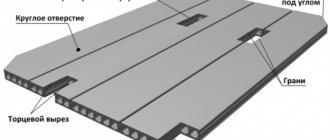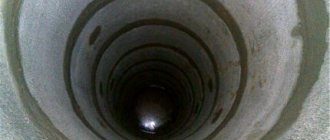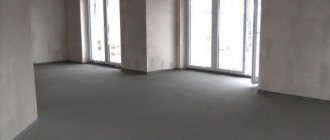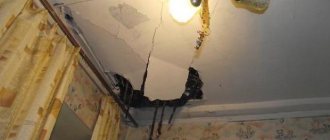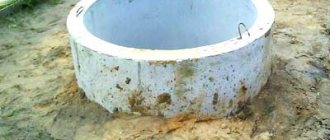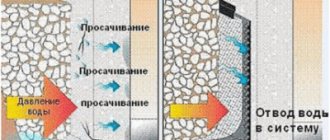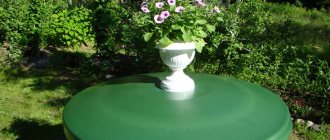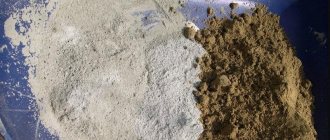Application area
This waterproofing material is widely used to eliminate leaks in various structures made of stone and concrete. Using hydroseals, they provide reliable waterproofing of joints of concrete rings, seams between blocks, and eliminate holes in water storage tanks, swimming pools, etc. Another application of a hydraulic seal is the urgent repair of broken water pipes, massive tanks, etc. — with its help you can seal the hole from which water flows (even under strong pressure). Thanks to this material, it is possible to minimize the potential damage that would be caused by an accident.
The use of a hydraulic seal is often an emergency measure, so it is advisable to avoid such incidents. What causes spontaneous water leaks? The answer is obvious - due to poorly equipped waterproofing of structures, most of which are constantly in contact with water. Therefore, it is extremely important to carry out preventive inspections, modernization and repairs of objects exposed to water in a timely manner. However, not even the most reliable structure is insured against unforeseen emergency situations, so in case of a leak in the basement or a burst water pipe, it is advisable to purchase a hydraulic seal.
Kinds
It should be kept in mind when choosing a hydraulic seal that they can be temporary or permanent . Permanent water seals do not require additional waterproofing after the leak has been eliminated. And temporary ones are needed to enable waterproofing and other work to be carried out in accordance with the project.
The material is prepared for work in small volumes in accordance with the technical description. Typically, mixing with water is done with hands wearing rubber gloves. The beginning of the reaction can be monitored by the intense release of heat.
To obtain a greater effect, it is necessary to prepare the base on which the hydroseal will be applied. It is cleaned of dirt, weak concrete and other separating layers. Then you need to properly press the prepared hydroseal with your hand and hold it until it sets completely. If the defect being repaired is large enough, it is treated in several steps.
If it is necessary to waterproof a vertical crack or seam, work should be started from the top point. As a rule, for this it is enough to use “fast” repair compounds, for example PROFLEX RS . Thus, we direct the water pressure to the lower point of the seam or crack, where a piece of hose is first inserted to allow the water to escape outward in order to reduce the pressure. Having reached the bottom point with repair compounds, it is necessary to remove the hose and seal the remaining section with a “permanent” hydraulic seal, for example KARAT FIX . If you used a “temporary” water seal, you need to perform surface waterproofing with a material, for example, PROFLEX 2K.
Preparation
Hydroseals are supplied in hermetically sealed containers and are a dry powder. To prepare a waterproofing composition, you need to take a small amount of this powder, pour it into a rubber or plastic container, and then start adding water. The chemical composition of hydroseals from any manufacturer is toxic and should not come into contact with the skin for a long time. Rubber gloves should be used as protective equipment. If the latter are available, you can mix the powder with water manually or using a spatula. When the mixture is ready for use, it begins to warm up. At this moment, you should quickly seal the hole with a hydraulic seal and wait for the resulting mixture to completely cure. The time period during which the hydroseal hardens can be adjusted by changing the heating or cooling of water and material. When mixing heated ingredients, they set faster. The exact hardening time is determined experimentally and depends on the brand of hydraulic seal purchased.
Hydraulic seal of the Peneplag brand
If you are installing a hydraulic seal for a well, then you may prefer the Peneplag composition, which is sold in the form of a dry powder and can be used after dissolving in water. It can be used to seal brick and concrete structures. The mixture hardens in 40 minutes, and for the same volume as mentioned above, you will have to pay 8,200 rubles. As practice shows, this solution is one of the fastest in terms of setting time. The remaining application requirements are similar to other hydroseals, for example, application should be carried out under conditions not lower than +5°. After sealing, the treated area must be moistened for 3 days, otherwise the filling will not become resistant to moisture and will quickly become cracked.
How to eliminate a leak in case of massive damage?
The leak repair technique described above is suitable for small damage. However, if the hole is large, then its elimination is carried out in several steps. If a leak is found in the basement, then first of all you should insert a hose into the resulting hole to divert the flowing water into some suitable container. And only then begin to repair the damage using a special coating waterproofing agent. There is one important nuance here. If the nature of the damage is such that there are separate areas with intense water flows, then it is not worth cementing them immediately. Only after the waterproofing coating has set can a hydroseal be applied. After the latter has cured, you need to again apply a layer of waterproofing agent, covering everything together - both the previous layer of waterproofing and the water seal. If you follow this technique, you will absolutely get a good end result - the basement will be completely dry and will be protected from further water leaks and the appearance of dampness. Large leaks in other places can be sealed in a similar way.
How to prepare your own solution to eliminate leaks
Manufacturers such as Waterplug, Peneplug, Puder-EX and others provide detailed instructions for preparing the finished solution. Liquid waterproofing for concrete is prepared as follows:
- The required amount of mixture and water is measured in the indicated proportions. The standard ratio of the volume of the mixture and water is 5 to 1, but if measurements are made by weight, then 1 kg of dry powder accounts for 150 g of water. When repairing leaks under high pressure, the proportion of powder increases to a ratio of 6 or 7 to 1.
- The water is heated to a temperature of 20°C.
- The components are mixed thoroughly and quickly (no more than 30 seconds) with gloved hands or using available tools. The ready-to-use solution is similar in consistency to dry soil.
The hydraulic seal for the well should be quickly mixed in the required proportions and pressed into the place where the leak has formed.
The air temperature during work should not fall below +5°C.
Dry waterproofing mixture
after adding water, it completely hardens within a few minutes, so it is worth preparing the solution in small portions, in the amount necessary to repair one damage.
The cost of the finished mixture is quite high, so sealing holes and non-pressure leaks that do not come into direct contact with water can be done using a homemade solution. To do this, without adding water, mix 2 parts sand and 1 part cement, after which the resulting composition is placed with a spatula in all. The repaired areas are covered with iron sheets for 2-3 days (the sheets can be secured using spacer strips). After 2-3 days, the sheets are removed, and the surface of the improvised hydroseals is covered with a layer of cement or other waterproofing solution.
During the construction process, it can be done using a mortar prepared on the basis of cement and PVA glue. For preparation, cement (1 part), sand (2 parts), water (1/3 of the total volume), PVA glue are used. This waterproofing for concrete is applied to a dry surface, into joints between reinforced concrete rings that have been pre-treated with a primer.
How to choose a hydraulic seal?
In the catalog of the website mpkm.org, hydroseals are presented in an assortment sufficient to solve various problems associated with emergency waterproofing. You can purchase hydraulic seals from both domestic (Hydrotex B) and European manufacturers at any time. The best and more expensive are compounds whose setting time does not exceed two minutes. For quick and reliable elimination of leaks in concrete and stone structures, hydraulic seals of foreign brands Lamposilex (Italy) and Sika-4a (Switzerland) have proven themselves well. If choosing the right composition seems difficult for you, you can get a free consultation at any time by calling the numbers listed on our company’s website.
Ready-made waterproofing seals
Ready-made hydraulic seals for concrete wells are very convenient: to use such a seal, it is enough to dilute the solution with water according to the manufacturer’s instructions. Let's look at the most popular waterproofing sealing mixtures.
Option #1: water plug. This mixture contains fine-grained quartz sand, aluminum cement, and active chemical additives that give the composition plasticity and allow it to quickly harden. Using this type of seal, you can quickly eliminate a leak within 2 minutes.
Injection stages
The procedure for injection waterproofing is the same for both options. It is important to carry out concrete repairs in the following sequence:
- Preparatory work - visual determination of the nature of the defects and careful preparation of surfaces for the introduction of the solution.
- Drilling holes for packers - drilling locations are marked, they should be located in a checkerboard pattern, at an angle of approximately 50° to the main surface. The holes are drilled to a depth of 2/3 of the wall thickness, and the distance between them should not exceed 25 cm.
- If it is planned to create anti-filtration protection, the holes are made through and located over the entire surface of the wall. In this case, the injection composition is pumped behind the supporting structure.
- Setting and strengthening packers for introducing solutions.
- Introduction of the injection composition through packers.
- Dismantling of auxiliary devices.
- After complete drying, the excess compound is removed, and the holes are sealed with a repair compound.
- The final stage - after all defects have been injected, before applying decorative finishing, the repaired area is covered with a sealing mixture. This will not only hide traces of the repairs being carried out, but will create an additional protective layer against the penetration of water or moisture.
Technology of injection of concrete structures
Carrying out injection repairs of concrete is not characterized by technological difficulties, but requires strict phasing of work. Correct execution of all stages of work helps to increase the performance of the structure without the need for major dismantling measures.
There are two options for injection waterproofing:
- Filling internal cracks, shells, water and air bags and voids;
- External application of waterproofing between the load-bearing surface and the soil, without removing it.
First of all, the composition for injection is selected. Much depends on the strength of the concrete and the presence of water inflow. If the strength of concrete exceeds B-20, and there is no water inflow, compositions based on epoxy resins are used. If the concrete strength is less than B-20 with the presence of water inflow, then cement-based compositions are suitable.
We invite you to find out how much they pay for cold water without a meter
In the prepared surfaces, holes are made with a Pobedit drill into which packers (injectors) are installed. They supply the injection composition, which is injected into the concrete structure being repaired or onto the inner surface under the primer layer. After drying and processing, the holes are filled with a repair compound.
Operating principle
The composition of the seal will restore the integrity of the structure in 5-10 minutes.
The components of the mixture, as well as the composition as a whole, must have a safety certificate for use in a drinking water environment.
Hydroseal is a special quick-hardening composition.
The components included in the composition give the material resistance to water.
The speed of solidification will allow you to eliminate leaks with high pressure. Conventional hydraulic compounds do not stop pressure leaks.
They are washed off with water pressure until complete hardening occurs.
Before the invention of hydraulic seals, the tightness of wells was restored using wooden plugs and tow. Swelling under the influence of water, such inserts prevented the movement of water.
Natural materials have a fatal drawback - in a humid and warm environment they are exposed to bacteria and fungi, which leads to rotting.
Particles of rotting wood and tow, getting into the water, gave it an unpleasant smell and taste.
With the advent of the hydraulic seal, the quality of work has improved and the service life of the repaired area has increased.
Despite the proven quality, you can find the use of outdated methods of restoring tightness.
It is impossible to stop a leak under pressure using a mixture of sand, cement and liquid glass.
Fixing leaks in the basement
To eliminate cracks inside basement walls, cement mixtures with quartz sand and water-repellent additives are most often used. The mastics we mentioned above are also actively used. In her practice, she uses insulation products of her own production, as well as gels, foams and elastic waterproof coatings from the brands “Hidrozo”, Drizoro and WDM.
In addition, water repellents are introduced into the surface structure, which do not penetrate deeply enough, so they are used to fill holes after injection repair of leaks in the basement.
The process occurs in three stages:
- Preparation, which includes cleaning concrete surfaces in order to open the smallest capillaries in its structure.
- After the cracks have opened, a primer layer is applied.
- The surfaces are specially moistened and after drying, an insulating composition is applied.
A team of experienced employees carries out work of any level of complexity in basements, ground floors and cellars. Complex work allows you to get quick results, and the use of insulating materials of your own production allows you to create an acceptable cost for services. Get advice and order specialists to visit your address, leave a request on the website or call the manager.
Restoration of cement-sealed or ceramic tiles
Factors that negatively affect roofing tiles are: - damage to tiles on roof overhangs and in areas where they join vertical parts;
- deformation of the roof due to the influence of weather (cracks are formed into which a humid environment enters). *NOTE. To prevent deformation of the roof, you need to strengthen the rafters with planks, thus strengthening the structure.
Also the cause of leakage is crumbled cement in the joint areas between the elements. In this case, you need to replace the unsuitable material with a new high-quality solution (lime with the addition of flax-based fibers and 2 parts sand). This substance can also be used to repair cracks in tiles.
The essence of the repair is to remove the waterproofing that has become unusable and install new material in its place. New slats treated with antiseptic are installed. The defective tile material is replaced with a new one.
Making a filling yourself
Self-made hydraulic seals have some features. They are somewhat inferior in quality to ready-made fillings produced by the industrial method.
These disadvantages include:
- there is no guarantee of inertia, i.e. a “homemade product” can come into contact with the environment, thereby changing its properties;
- a homemade filling hardens much slower than an industrially produced one;
- there is a possibility of the seal disintegrating and its components getting into the water.
Based on the last point, we do not recommend using toxic compounds to create “homemade” hydroseals!
The advantages of homemade seals include low cost and availability, which is especially important in emergency cases when there is no industrial seal at hand.
#1: Homemade pressure-free seal
To prepare a waterproofing seal, the following materials are needed: fine-grained, preferably sifted sand, cement of a grade not lower than M300. Proportions – 2 parts sand + 1 part cement. Immediately before use, water is added to the composition.
Water must be added gradually, stirring constantly. The consistency should be thick so that the mixture can be easily formed into a ball that will not spread.
The filling is applied to a large crack by hand, and rubbed into a small crack with a spatula. After the repair is completed, the well section must be covered with an iron plate. After 2-3 days, the iron is removed, and the filling is treated with cement mortar and covered with waterproofing.
This method can only be used to eliminate non-pressure and low-pressure leaks. Under high pressure (over 3 atmospheres), such a homemade composition is quickly washed out.
#2: Seal for seams and small cracks
Despite all their shortcomings, homemade hydraulic seals are excellent for sealing seams in concrete wells. They cope with this task “excellently”, while allowing you to save a significant amount on industrially produced products.
Being environmentally friendly and safe, homemade hydraulic seals made of sand and high-quality cement reliably protect well water from the ingress of groundwater, impurities, and soil.
To increase the efficiency of waterproofing the seams of a well, a “liquid glass” composition can be added to the solution of sand and cement. This mixture will make the sealing better and more durable. Proportions 1:1:1 (sand:cement:liquid glass). It is necessary to add “liquid glass” 1 minute before sealing, because The composition hardens very quickly!
Materials for crack injection
In modern construction, a wide variety of injection materials are used. A wide selection allows you to choose a composition that will become one with the concrete structure, strengthen it as much as possible and make it completely waterproof.
Cement compositions
Used for concreting small elements of complex shapes and hard-to-reach areas. Micro cementitious compositions are resistant to shrinkage, which helps prevent various defects.
Polymer compositions
Polymer-based materials today are the most popular in construction and repair for injecting cracks and creating a waterproofing layer. The main advantage of polymers is their ability to harden. When exposed to moisture, polymers increase in volume, resulting in a dense, durable structure.
Resin-based injection compounds are ideal for repairing porous materials, bonding large cracks in concrete structures, and protecting cutoffs from moisture. Polyurethane resins combine well with other compounds, and are often used in complex injection with composite materials. This technique significantly increases the strength of a concrete structure and makes it inaccessible to harmful climatic influences.
The basis of such compositions is silicone with the addition of silicon. They are used mainly for injection waterproofing of porous materials, but are indispensable in carrying out repair work on old concrete structures. Organosilicon liquids perfectly fill large air or water voids and pockets, easily penetrate into the narrow passages of internal cracks, filling them with a durable material with high adhesive properties.
Injecting FBS blocks on the basement staircase

